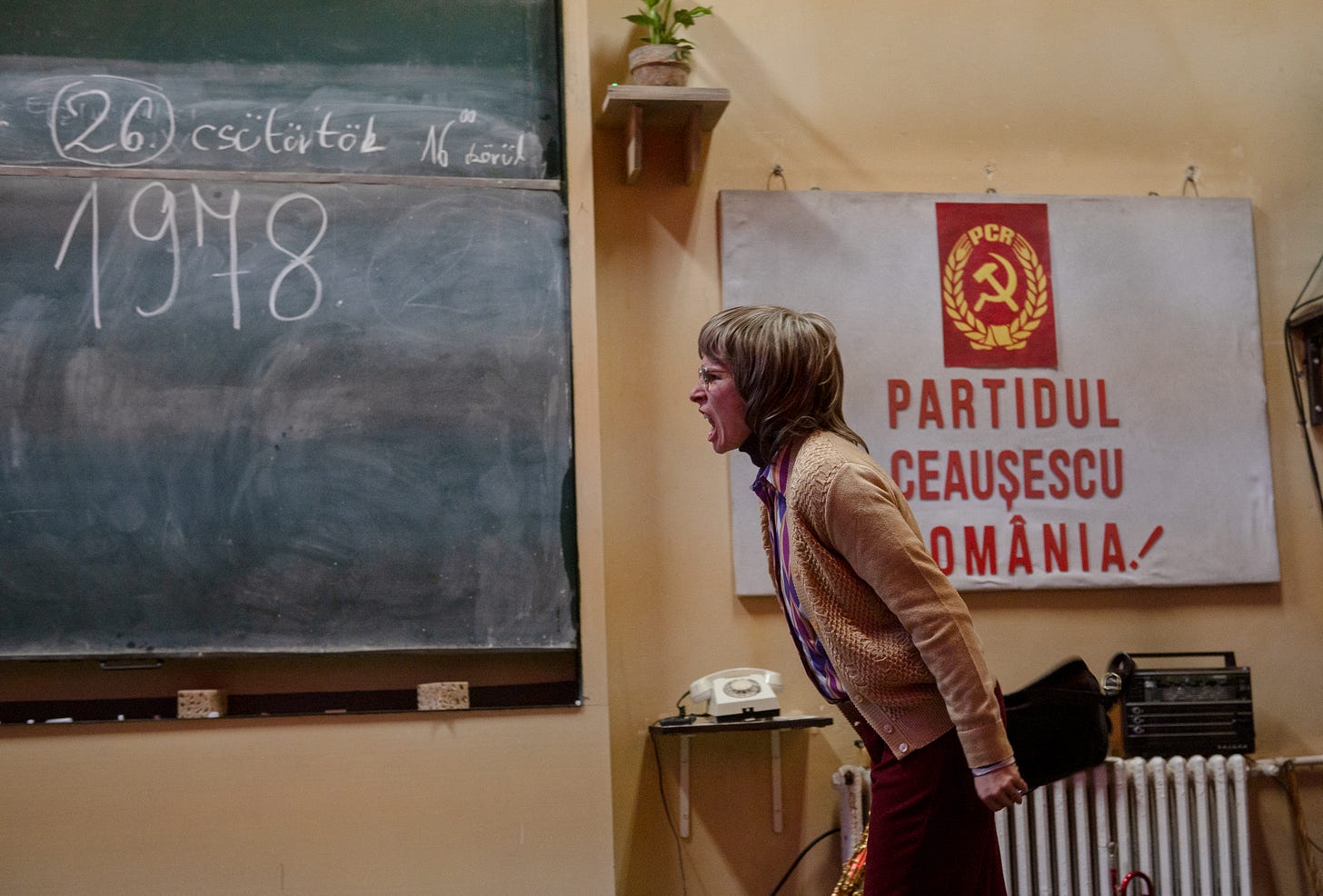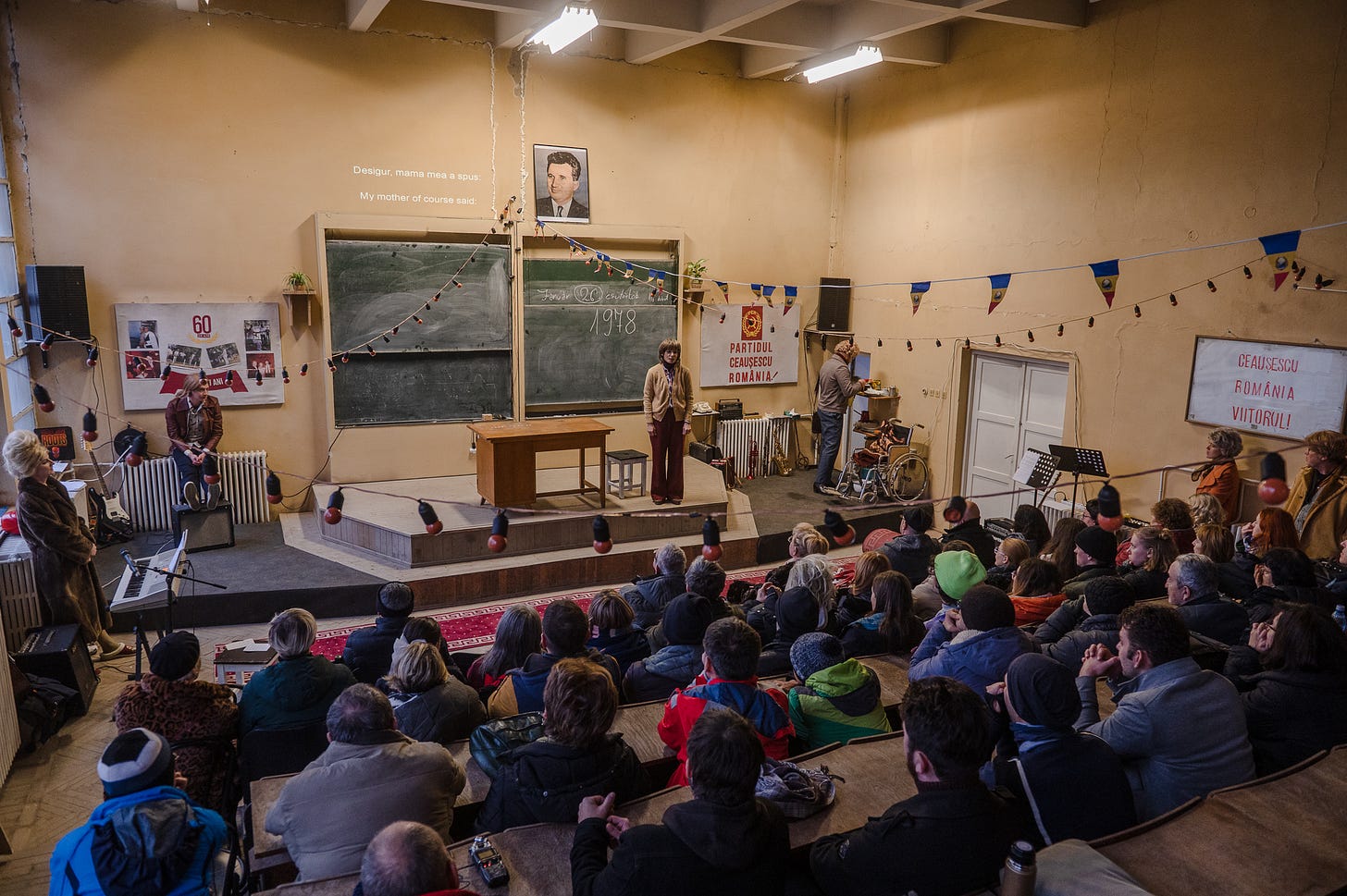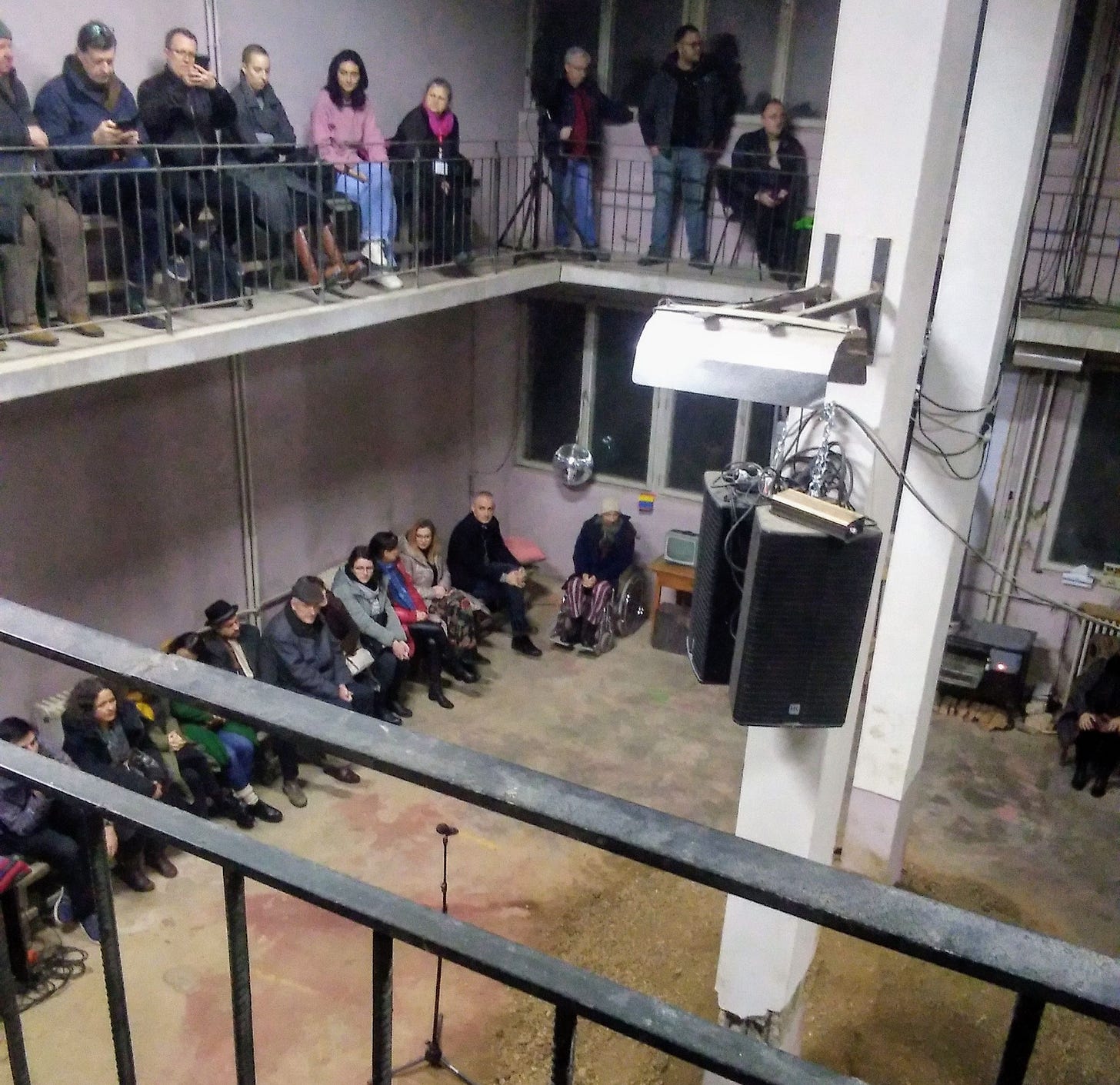A dance to the music of time: Tomi Janežič’s 1978
On the Slovenian director's ambitious 12-part exercise in turning memories into theatre.
This week’s newsletter comes to you from Timișoara, a culturally mixed and very pretty city in the west of Romania near the borders of Hungary and Serbia. It was a European Capital of Culture in 2023 and last week hosted a joint showcase of the work of the Hungarian State Theatre “Csiky Gergely” and the German State Theatre, which conveniently/confusingly share the same building - though the performance I was there to see actually took place a short way out of town.
If you want to support my writing while keeping this site largely paywall-free (though there will be occasional paid subscriber bonus posts, like this recent round up of theatre I saw in London), you can do so for just £5 a month or £50 a year. Or just share this newsletter with someone you think might find it interesting. That helps too.
The old Hydrotechnics faculty of the University of Timisoara is located a short bus ride away from the city centre. For years it’s stood empty. There are cracks in the concrete, pieces of rebar peeking through. Some of those Toi-Toi porta-toilets have been parked in the grounds. There’s no central heating. We’ve been advised to dress warmly. Later, I will be grateful I brought my gloves. A sign above the entrance celebrates the “brotherly friendship” between the people of Romania and Yugoslavia.
This building is the site of Slovenian director Tomi Janežič’s sprawling, four-hour memory play, 1978, a piece which spans the decades from pre-revolution Romania to the First World War. The show forms one chapter in Janežič’s immensely ambitious ‘dodecalogy’ project, a series of twelve performances covering the years 1972-1983, which forms part of GO!2025, the European Capital of Culture programme in Nova Gorica, Janežič’s hometown. Nova Gorica shares a border with Gorizia in Italy, making this the first ever cross-border Capital of Culture. (Here’s a good BBC article about the history of the two cities).
Created in conjunction with theatres across Romania, Serbia, Ukraine and Slovenia, Janežič’s project forms a kind of performative document of life in the former Yugoslavia and surrounding region in the 1970s and early 80s. I’ve been fascinated by this project since I first read about it and previously wrote about the Serbian section, 1981, which was performed by the Hungarian Theatre in Novi Sad - I hope to see more pieces before the year is out.
Though 1978 sits midway through the chronology of the project, it was actually the first piece to premiere, opening in December 2023 when Timisoara was European Capital of Culture. It’s produced by the Csiky Gergely Hungarian State Theatre în Timișoara, which has a history of programming ambitiously. The theatre shares a building with the German State Theatre, reflecting its position in a Romanian city with a significant Hungarian, German and Serbian population.
1978 is best described as site-response rather than site-specific – they’ll obviously need to find somewhere new to stage it in Nova Gorica – but the boxy post-war building does a good job of transporting us through time. As Attila Balázs, who is the general manager of the Csiky Gergely Hungarian State Theatre as well as one of the performers in the piece, explains Janežič fell in love with the space when he saw it. “It is saturated with the period of communism,” he says. The fact that it was in state of disrepair and had no heating wasn’t a deterrent. At one point the electricity went out during a performance and they continued regardless – it just added to the atmosphere.
The show is divided into three chapters, the first of which takes place in an old lecture theatre with a blackboard and wooden seating, late afternoon sun streaming through the streaky windows. The cast kicks things off with a song. It is 26th January, the sixtieth birthday of Nicolae Ceaușescu and celebrating is mandatory. The story is narrated by Zsolt – actor Zsolt Mátyás, who we hear more than we see - who as a child was given the responsibility (and pressure) of writing a letter to Ceaușescu on his big day.
The show captures the minutiae of life under communism, the cramped apartments and shared bedrooms, the illicit listening parties in which people would gather to listen to records on homemade headphones, the uncle who would annoy everyone by taking hour-long cold showers, the 96-year-old great grandfather who would spend his days parked in a wheelchair by the window, obstructing the fridge. On weekends, everyone would gather round the television to watch Roots. A picture of Ceaușescu hangs on the wall, watching over the family as they string fairy lights around the space. Ceaușescu is very present in the piece. While it’s never spelled out, we witness the way the regime impacts on everyday life. One family friend gets beaten up for wearing a Rolling Stones T-shirt. Apparently during the devising process there was even talk of Ceaușescu and Elena being portrayed on stage, but they decided, I think wisely, against it. We still get a sense of the way he looms over people’s lives.
The show has the texture of memory. This is largely because of how it was created. At the start of the process, the actors were invited to share their memories during workshops with the director. While some shared personal memories of life under communism, the younger members of the ensemble brought stories of their parents and grandparents. They improvised around this material and then Janežič’s and the Slovenian playwright Simona Semenič went away and wove their stories into a single, decade-straddling family drama in which all their memories and stories are intermingled. The term they’re using for this process is ‘documentary fiction’ and the personal nature of the material informs the performance throughout. It is studded with the kind of small details a child would recall, the kind of stories that get passed down through generations, evolving and mutating along the way.
As in 1981, the second section of the show kicks off with a video interlude by Italian actor Carlo Zoratti that adds a little context, showing the audience some of the locations mentioned in the piece, as well as being very funny, with throwaway gags about Berlusconi peddling porn and Francesco Illy, founder of the coffee company, who came from Timisoara. Zoratti’s delightfully deadpan mode of delivery also provides a nice tonal contrast to the rest of the show. These videos are also a way of linking all the pieces of the dodecalogy project together, since they will feature in each of the 12 pieces. The video ends with a joke about the “the fourth wall” that also wittily exploits the potential of this found location, as a motorised door suddenly lifts to reveal a recreation of a communist-era apartment (lots of lovely details by designer Branko Hojnik, from the enamel cookware to the abundance of brown furniture). History and memory are further interwoven. There are digressions about Franz Joseph and the First World War I, the suicide of Crown Prince Rudolf and the assassination of Empress Elizabeth – Sisi - of Austria, stabbed in the chest by an Italian anarchist. The piece joins the dots between these historical events - the waning Austro-Hungarian Empire - with the day-to-day and the domestic.
1981 did something similar, deftly connecting the micro and the macro, rooting us in a particular time, on a thread that connects the past with events yet to come. The Romanian revolution started right here in Timisoara, in December 1989, before sweeping across the country, ending 42 years of communism. The piece is as shaped by the events of the past as it is by the future.
In the third and final part, the audience is ushered into a massive double-height room with a balcony on which some of the audience sit, while the rest sit in the room below. There is a big hole in the floor, a man digging in it as if unearthing long-buried things. This last section is far more expressionistic in tone, the already fragmented piece fragmented further as we plunge into the past, into the First World War when soldiers from the 61st infantry regiment from Timisoara fought in what is now Slovenia.
It becomes a little difficult to keep up with who’s who during this section, but it doesn’t matter; if anything, it’s kind of the point. We’re in the mist of memory now, in the haunted mind of a 96-year-old man. Soldiers huddle in the trenches, sheltering their wounded comrade. Copious amounts of viscous red liquid are poured over the actors’ heads while hand-held smoke machines are used to fog the air around them in a way that reminded me of the “green sea” of mustard gas in the poetry of Wilfred Owen. It’s cacophonous and confusing, repetitive and woozy. Certain images recur: black ash falling from the sky, those communist-era carpet hangers which used to stand outside apartment blocks. Bloodied bodies are dragged around the stage while the other characters look on. Sometimes they address us via microphone. It’s sort of post-dramatic but there are constant shifts between modes of performance, and by the end the play text itself even appears on stage. There’s a fuck-tonne of stuff going on basically – by the end of the show the floor is slick and crimson and glitter-flecked, the air hazy - but it all adds up into a disorientating if exhilarating whole.
This is a show constantly foregrounds the fact that it’s a piece of theatre. Everyone uses their real names. The actors sport a variety of not particularly well-fitting wigs as well as era-appropriate clothing (paisley print skirts and brown leather jackets plus those Rolling Stones T-shirts). Near the start of the show actor Atilla Kiss has a beard glued on to his face to portray the great grandfather, whose character forms the bridge between the past and present. At the end of the second sequence, the actors clear away the furniture inside the apartment, carting out the TV and fridge, stripping it bare, until all that’s left is an empty room.
The show is also long – even though it’s been trimmed down a bit since the premiere, it still runs to around four hours, about the same length as 1981 (which is the essence of brevity in comparison to Janežič’s earlier 10-hour long show, No Title Yet). Concision isn’t in his toolbox and yet his work holds the attention in the way that shorter, tauter plays sometimes do not. They’re experiential in nature – at one point, we’re handed cups of fruity tea to warm us up - and compellingly novelistic, with each piece feeling like its own chapter.
Above all, it’s a fascinating document. In a region not immune to historical revisionism, where Yugoslavia is often framed as either a socialist utopia or a brutal dictatorship, Janežič’s 12-part project is an act of collective remembering. As previous generations slip away taking their stories with them, this project acts as a kind of memory tapestry, a shimmering link with the past.
This week in European theatre
Testo – Drag artist and queer club regular Wet Mess – profiled here in the Guardian - presents a surreal, spectacular fusion of movement and pre-recorded interviews with people who have taken testosterone. Originally presented as part of the Here & Now Showcase at last year’s Edinburgh Fringe it’s at London’s Battersea Arts Centre until 22nd February.
White Widow - Iraqi-born Austrian filmmaker and screenwriter Kurdwin Ayub, whose films include the Florentina Holzinger-starring Moon, makes her theatre debut with what is described as an “utopian erotic adventure” set in the year 2666. It has its world premiere on 14th February at the Volksbühne in Berlin.
Attempts on Her Life - Lilja Rupprecht’s production of Martin Crimp’s twisty exploration of identity, in a German translation by Falk Richter, was supposed to open at the Schaubühne last year, but the premiere was postponed. The rescheduled performance opens in Berlin on 16th February
Thanks for reading! If you’d like to get in touch about anything newsletter-related, you can reach me on natasha.tripney@gmail.com









